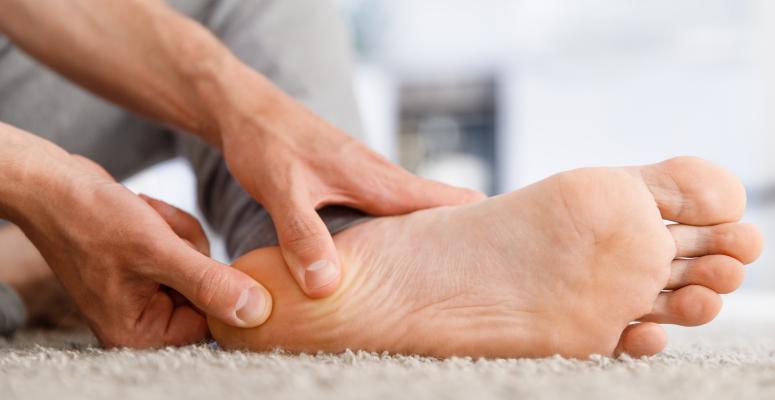
Painful foot conditions can be very frustrating to deal with because they affect your day-to-day living. They can make it difficult to walk or stand too long, which can prevent you from doing things like walking long distances during a vacation or standing during a concert.
There are a variety of different reasons that can explain why your feet are hurting, but two common conditions are heel spurs and plantar fasciitis.
The basics of plantar fasciitis
Plantar fasciitis is a common condition that affects the heel of the foot. It’s estimated that 1 in 10 people will develop the condition in their life, and it refers to inflammation of the plantar fascia, which is a ligament that connects the heel to the front of the foot.
Pain extending outward from the heel is the only symptom of plantar fasciitis, but it can flare up in different ways. People might feel an ache or burn in their foot after sitting or lying down for an extended period of time. The pain often increases after strenuous activity, but it may not be very noticeable during activities like walking.
Here are a few factors that could increase the risk of developing this heel condition:
- Obesity.
- Long-distance running.
- Having a job requiring extended time on your feet.
- Unsupportive shoes.
- Flat feet or high arches.
- Tight Achilles tendons.
The basics of heel spurs
Calcaneal spurs, or heel spurs, are calcium deposits that can grow between the arch and heel bone. They are bonelike growths that aren’t always visible and can grow to half an inch.
Heel spurs are usually found underneath and at the front of the heel, but they can affect other parts of your foot as they grow.
Heel spurs don’t always have symptoms, but some can cause:
- Pain.
- A bony protrusion.
- Swelling at the front of the heel.
- Inflammation.
- Warmth to the touch.
While 1 in 10 people have heel spurs, only 1 in 20 of those with spurs will experience pain.
How to tell if you have heel spurs or plantar fasciitis
Heel spurs and plantar fasciitis both affect the heel of your foot, so how can you tell which one is causing your pain?
Both of these foot conditions are usually caused by too much strain or pressure on the foot and ligaments. They can also both be caused by:
- Arthritis.
- Obesity.
- Unsupportive shoes.
- Unnatural gait.
Many may think that heel spurs are actually the cause of plantar fasciitis, but this theory is untrue. But people with plantar fasciitis do have an increased risk of developing heel spurs.
It may seem like these foot conditions are hard to differentiate from one another, but there are a couple of distinctions that can help you pinpoint what's causing your pain. For instance:
- Heel spurs are actual growths while plantar fasciitis is internal damage done to the muscle and ligament.
- While a podiatrist can often determine if you have plantar fasciitis through a physical exam, spurs can be difficult to find without an X-ray.
- Spurs can cause pain at the front of the heel, while plantar fasciitis flares out from the back of the heel.
How to treat heel conditions
Now that you know how to determine whether you have plantar fasciitis or heel spurs, it’s time to figure out the best treatment.
Heel spurs won’t heal without surgery, but a procedure is rarely necessary unless there is pain that worsens over time. Your podiatrist may recommend corticosteroid shots to alleviate the pain.
If you are experiencing symptoms of heel spurs, the at-home treatments are similar to those used for plantar fasciitis. Ice and over-the-counter pain medications can help ease discomfort. Rest is also essential, especially if you find that you’re spending extended periods of time on your feet.
Physical therapy for plantar fasciitis and heel spurs
Physical therapy can be highly beneficial for people dealing with plantar fasciitis as well as pain from heel spurs. Physical therapists can assist you with exercises that will strengthen the supporting muscles and improve the flexibility of both your ankle and plantar fascia. These exercises can also help with heel spur pain management.
Physical therapists can provide manual therapy, which can be used to loosen the soft tissue in your foot to alleviate the pain.
Not only will a physical therapist provide you with the exercises and techniques you need, but they can also give you an assessment on how to correct your gait. Learning about your imbalances can help you with long-term pain management.
Alliance PTP is ready to help you find top-notch PT for plantar fasciitis and heel spurs
At Alliance Physical Therapy Partners, we’re proudly bringing together physical therapy practices across the country to help people get the high-quality PT they need.
Want to see a physical therapist in person? We can put you in touch with an Alliance PTP partner that’s close to you and that can help you address plantar fasciitis and/or heel spurs.
Not keen on in-person PT sessions or not close to an Alliance PTP partner? No worries. We also offer effective and affordable virtual physical therapy through our Agile Virtual Physical Therapy platform.
Come find help for your injury or chronic condition today!
Get Help at a Location Near You
